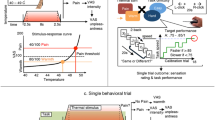Abstract
We compared several strategies for coping with acute induced pain, and examined self-efficacy perceptions, outcome expectations, and attention to pain as cognitive mediators of pain tolerance. The coping strategy of central interest was an overt performance task selected to be highly distracting. Sixty-four subjects were randomly assigned to either overt performance distraction, verbal—imaginal distraction, relaxation, or no strategy. Before and after strategy training, subjects completed measures of cold-pressor pain tolerance, subjective pain, perceived self-efficacy, anticipated painful outcomes, and attention to pain. The performance strategy enhanced pain tolerance much more than did the verbal—imaginal or relaxation strategies. Self-efficacy perceptions accurately predicted individual differences in tolerance even when anticipated pain, subjective pain, or attention to pain were held constant. With self-efficacy held constant, attention predicted tolerance but anticipated pain did not. The findings suggest that self-efficacy perceptions and attention deployment both influence individuals' pain-coping ability.
Similar content being viewed by others
References
Bandura, A. (1977). Self-efficacy: Toward a unifying theory of behavioral change.Psychological Review, 84, 191–215.
Bandura, A. (1984). Recycling misconceptions of perceived self-efficacy.Cognitive Therapy and Research, 8, 231–255.
Bandura, A. (1986).Social foundations of thought and action: A social-cognitive theory. Englewood Cliffs, NJ: Prentice-Hall.
Bandura, A., Cioffi, D., Taylor, C. B., & Brouillard, M. E. (1988). Perceived self-efficacy in coping with cognitive stressors and opioid activation.Journal of Personality and Social Psychology, 55, 479–488.
Bandura, A., O'Leary, A., Taylor, C. B., Gossard, D., & Gauthier, J. (1987). Perceived self-efficacy and pain control: Opioid and nonopioid mechanisms.Journal of Personality and Social Psychology, 53, 563–571.
Fan, Z. (1989).Belief manipulation and coping strategies in pain tolerance and pain perception: A self-efficacy analysis. Unpublished master's thesis, Lehigh University.
Holroyd, K. A., Penzien, D. B., Hursery, K. G., Tobin, D. L., Rogers, L., Holm, J. E., & Marcille, P. J. (1984). Change mechanisms in EMG biofeedback training: Cognitive changes underlying improvements in tension headache.Journal of Consulting and Clinical Psychology, 52, 1039–1053.
Kazdin, A. E. (1978). Conceptual and assessment issues raised by self-efficacy theory.Advances in Behaviour Research and Therapy, 1 177–187.
Litt, M. D. (1988). Self-efficacy and perceived control: Cognitive mediators of pain tolerance.Journal of Personality and Social Psychology, 54, 149–160.
Manning, M. M., & Wright, T. L. (1983). Self-efficacy expectancies, outcome expectancies, and the persistence of pain control in childbirth.Journal of Personality and Social Psychology, 45 421–431.
McCaul, K. D., & Malott, J. M. (1984). Distraction and coping with pain.Psychological Bulletin, 95, 516–533.
Melzack, R., Weisz, A. Z., & Sprague, L. T. (1963). Strategems for controlling pain: contributions of auditory stimulation and suggestion.Experimental Neurology, 8, 239–247.
Reese, L. B. (1983).Coping with pain: The role of perceived self-efficacy. Unpublished doctoral dissertation, Stanford University.
Tan, S. Y. (1982). Cognitive and cognitive-behavioral methods for pain control: A selective review.Pain, 12, 201–228.
Teasdale, J. D. (1978). Self-efficacy: Toward a unifying theory of behavioral change?Advances in Behaviour Research and Therapy, 1, 211–217.
Turk, D. C., Meichenbaum, D., & Genest, M. (1983).Pain and behavioral medicine. New York: Guilford Press.
Vallis, T. M., & Bucher, B. (1986). Self-efficacy as a predictor of behavior change: Interaction with type of training for pain tolerance.Cognitive Therapy and Research, 10, 79–94.
Weisenberg, M. (1977). Pain and pain control.Psychological Bulletin, 84, 1008–1044.
Williams, S. L., Dooseman, G., & Kleifield, E. (1984). Comparative effectiveness of guided mastery and exposure treatments for intractable phobias.Journal of Consulting and Clinical Psychology, 52, 505–518.
Williams, S. L., Kinney, P. J., & Falbo, J. (1989). Generalization of therapeutic changes in agoraphobia: The role of perceived self-efficacy.Journal of Consulting and Clinical Psychology, 57, 436–442.
Williams, S. L., Turner, S. M., & Peer, D. F. (1985). Guided mastery and performance desensitization treatments for severe acrophobia.Journal of Consulting and Clinical Psychology, 53, 237–247.
Williams, S. L., & Watson, N. (1985). Perceived danger and perceived self-efficacy as cognitive determinants of acrophobic behavior.Behavior Therapy, 16, 136–146.
Author information
Authors and Affiliations
Additional information
This research was supported by United States Public Health Service grants 5R29MH42385 and S07RR07173.
Rights and permissions
About this article
Cite this article
Williams, S.L., Kinney, P.J. Performance and nonperformance strategies for coping with acute pain: The role of perceived self-efficacy, expected outcomes, and attention. Cogn Ther Res 15, 1–19 (1991). https://doi.org/10.1007/BF01172939
Issue Date:
DOI: https://doi.org/10.1007/BF01172939




